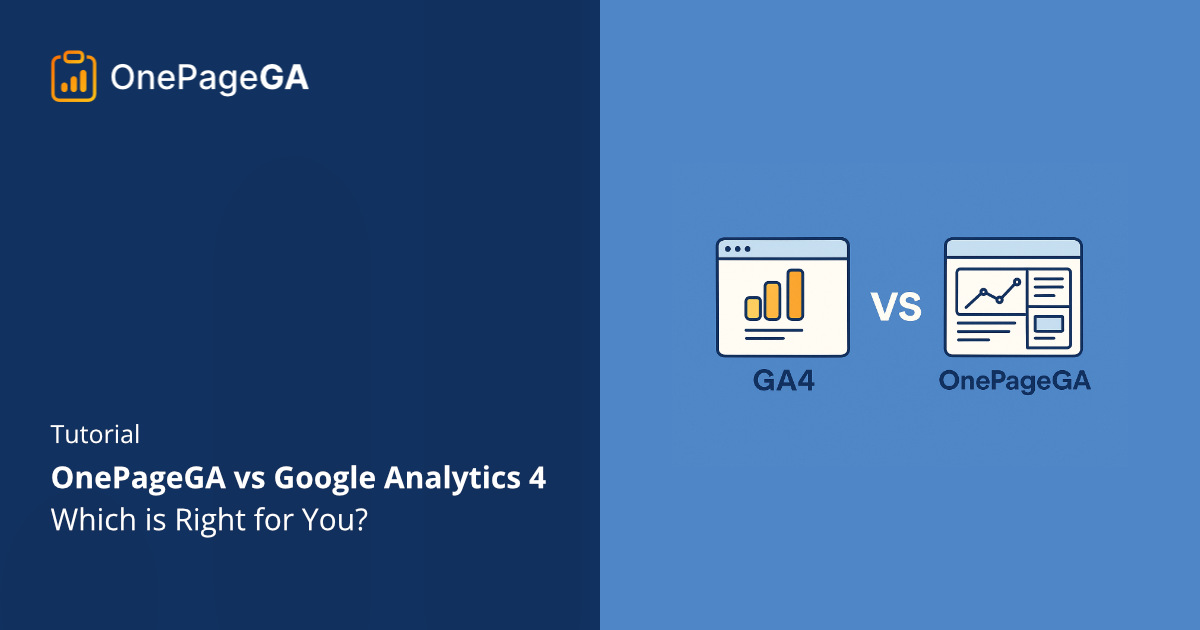Google Analytics 4 (GA4) is a free tool from Google that tracks how people use your website. It’s powerful, but many business owners find it complicated and time-consuming.
OnePageGA makes things easier. It connects to GA4 and turns the data into a simple dashboard that highlights the numbers you actually need to grow.
In this guide, I’ll compare OnePageGA vs Google Analytics 4 so you can decide if GA4 on its own is enough, or if using it with OnePageGA is the better choice for your business.
How I Compared OnePageGA vs GA4
To make this a fair comparison, I looked at the areas that matter most when choosing an analytics tool:
- Ease of setup and learning curve: How easy is it to set up and start using? Do you need technical skills?
- Reporting and dashboards: Are the reports clear and simple to understand? Can you find data quickly?
- Focus on business metrics: Does it highlight the numbers that matter most, like conversions and top pages?
- Customization and flexibility: Can you adjust the dashboards and reports to fit your goals?
- Integrations and workflow: Does it connect with other tools and fit smoothly into daily use?
- Pricing and support: How much does it cost, and what kind of help is available if you get stuck?
These criteria give a clear framework for comparing GA4 and OnePageGA side by side, so you can see which tool better fits your needs.
What is Google Analytics 4?
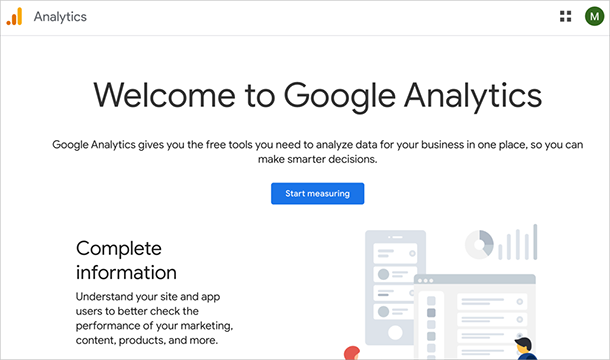
GA4 is Google’s latest tool for tracking what people do on your website. It replaced Universal Analytics and is now the standard way to collect website data.
GA4 tracks actions, called events, instead of only counting page views. An event can be anything a visitor does, like clicking a button, scrolling a page, or making a purchase. This makes it easier to see the full customer journey.
Key features include:
- Event tracking without extra setup
- Insights powered by machine learning
- Custom reports for deeper analysis
GA4 is free and very flexible, but it also has a steep learning curve and can feel confusing to new users.
What is OnePageGA?
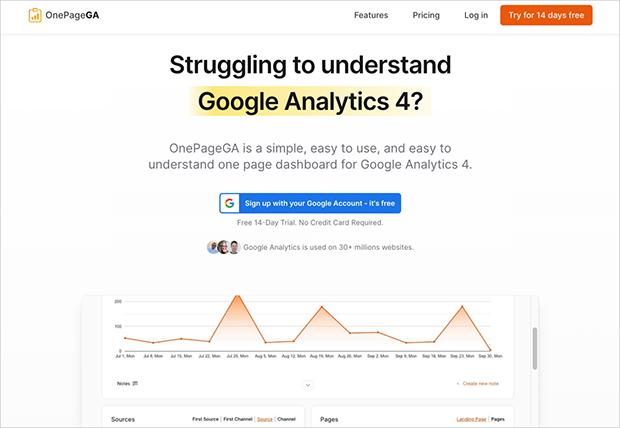
OnePageGA is a web-based tool that works with GA4 to make your data easier to understand. Instead of showing dozens of menus and complex reports, it puts the most important numbers into one clear dashboard.
The setup is quick, and you don’t need technical skills to use it. Once connected, you can see key business metrics like conversions, top content, and referral traffic in one place.
Key features include:
- A simple dashboard that’s easy to read
- Focus on business goals instead of every possible metric
- Fast setup with no coding required
OnePageGA doesn’t replace GA4. You still need GA4 to collect the data. But OnePageGA saves you time by turning that data into insights you can act on right away.
GA4 vs OnePageGA: Feature Comparison
Now that you know what each tool does, let’s compare them side by side. I’ll break down how GA4 and OnePageGA stack up in the areas that matter most for business owners.
Ease of Setup & Use
GA4 can be tricky to get started with. You need to create a property, add tracking code to your site, and often set up Google Tag Manager if you want to track specific events.
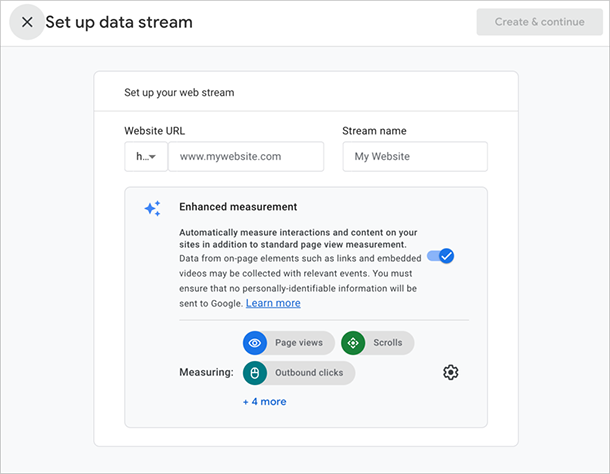
It’s flexible, but for most small business owners the process feels technical and time-consuming.
If you do want to give it a try, I’ve written a full guide on how to add GA4 to your website that walks you through the steps.
OnePageGA, on the other hand, is built for speed. You simply connect it to your GA4 account, pick your website, and your dashboard is ready. No coding, no tags, no long setup process.
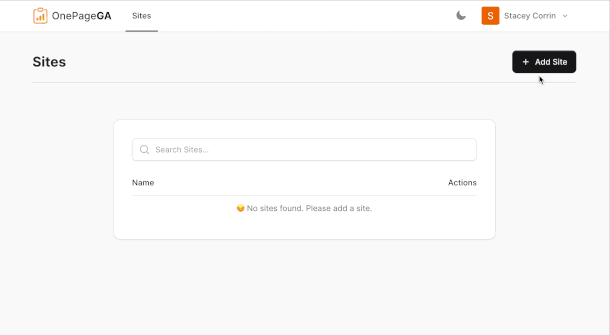
In my experience, GA4 is better suited for analysts who enjoy digging into setup, while OnePageGA is the clear winner if you just want to get insights right away.
Dashboards & Reporting
One of GA4’s strengths is that it can show almost any report you can imagine. The problem is you often have to build those reports yourself, and the default views don’t always highlight the numbers a business owner cares about.
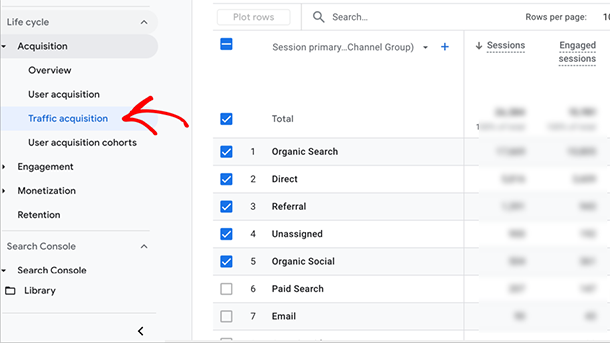
With OnePageGA, reporting is ready from day one. Instead of digging through menus, you see your most important numbers in a single view. It focuses on clarity rather than showing everything at once.
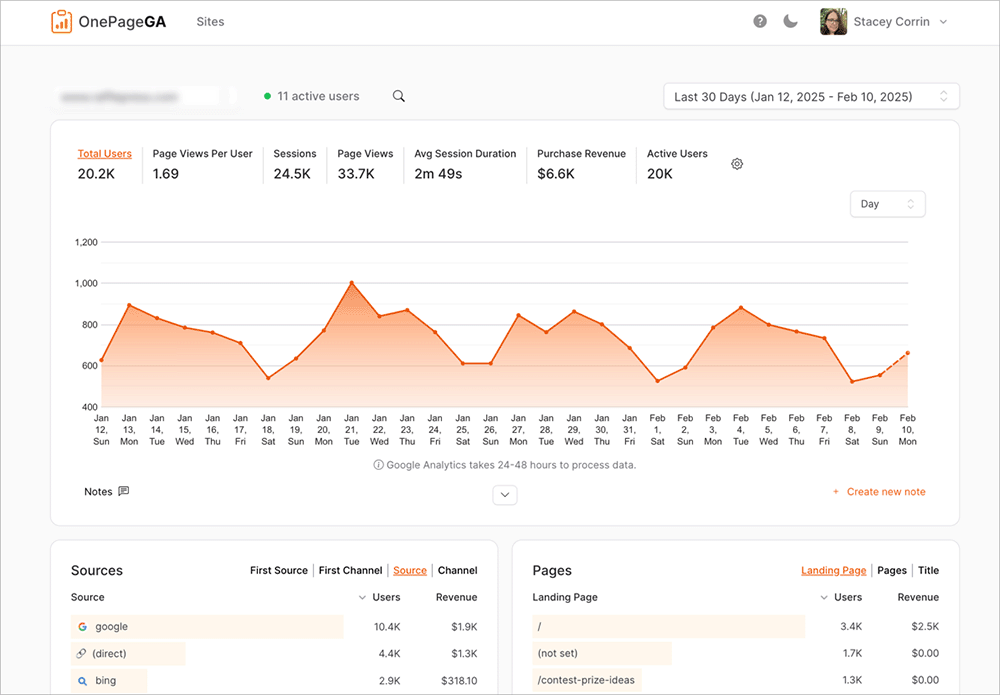
If you enjoy customizing reports and exploring data in depth, GA4 gives you endless flexibility. But if you’d rather skip the setup and get clear answers fast, OnePageGA makes reporting simple and practical.
For a complete walkthrough, you can also see our guide on how to create simple Google Analytics reports.
Metrics That Matter
GA4 tracks almost everything that happens on your site, from page views to scrolls to custom events. That level of detail is powerful, but it also makes it easy to get lost in the data.
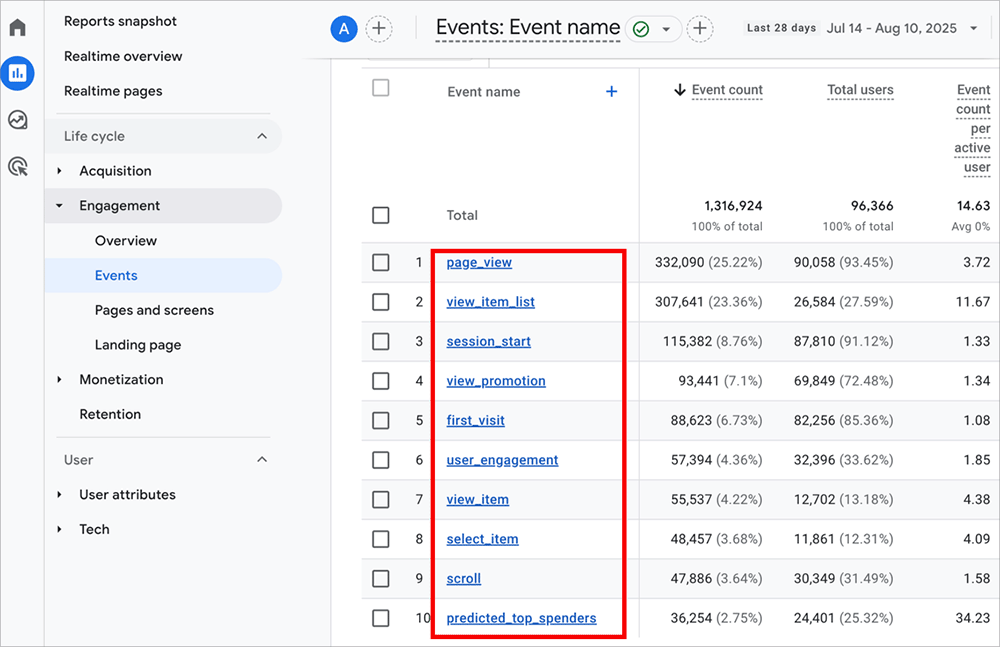
See our guide to learn what is a metric in Google Analytics. Most small business owners just want to know what is driving sales or signups.
OnePageGA narrows the focus. Instead of showing every possible number, it highlights the key growth metrics that tie directly to your goals. This makes it easy to see what is working without wasting time digging through reports.
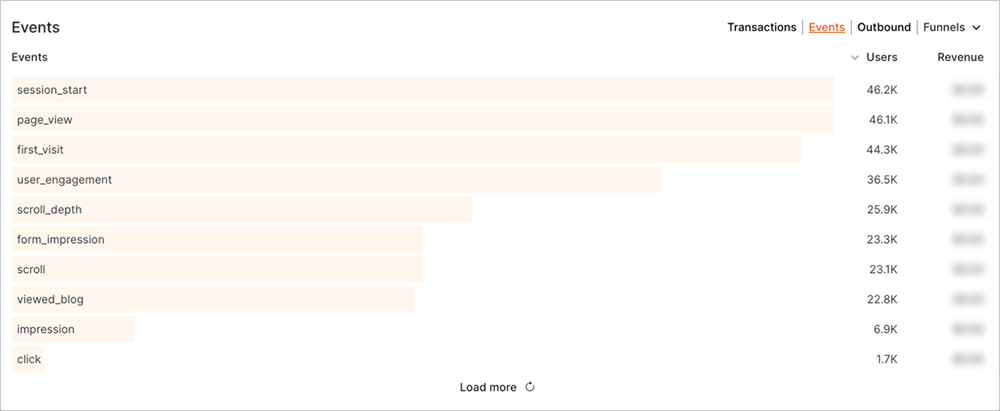
In short, GA4 is best if you want complete flexibility, while OnePageGA is built for clarity and speed.
Customization & Flexibility
GA4 gives you almost unlimited ways to customize your reports. You can build dashboards from scratch, apply filters, and even design advanced funnels that track every step of a customer journey.
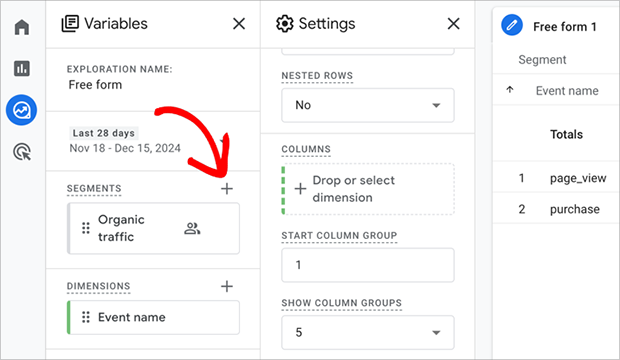
This flexibility is great if you know what you are doing, but it takes time to master.
OnePageGA offers light customization that stays simple. You can choose which metrics to show, reorder sections, adjust date ranges, and apply basic filters.
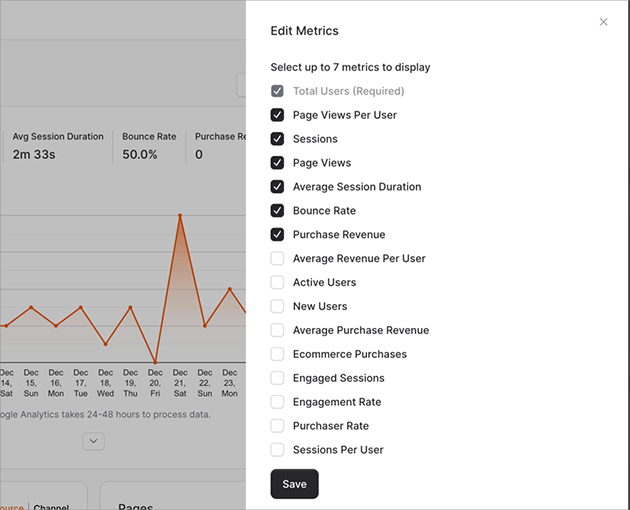
You can also tailor the dashboard to your goals without touching code.
If you need full control and do not mind the work, GA4 is the better fit. If you want quick adjustments with a clean, focused view, OnePageGA keeps things simple.
Integrations & Workflow
GA4 fits naturally into the Google ecosystem. It integrates with Google Ads, BigQuery, and Looker Studio, making it a strong choice if you already rely on those tools.
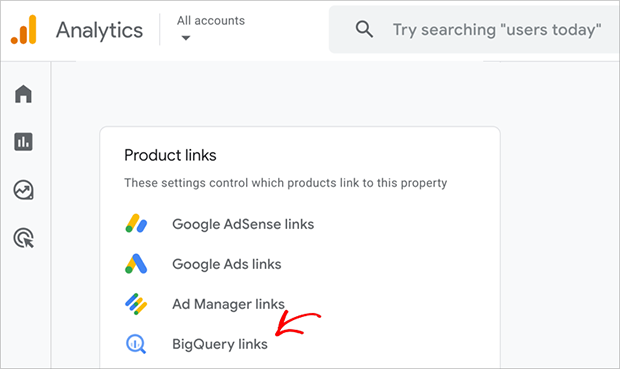
The workflow, however, can feel heavy. You often need to jump between platforms to pull insights together.
OnePageGA keeps things simple. It connects directly to your GA4 account and pulls the most useful data into one dashboard. While it doesn’t replace advanced integrations like BigQuery, it makes day-to-day analytics easier for business owners and marketers.
Pricing
GA4 is completely free to use, which makes it appealing for anyone who wants to track site data without extra cost. The trade-off is the time you spend learning how to use it.
OnePageGA offers a 14-day free trial with no credit card required. After that, pricing depends on the plan:
- Personal: $10/month – best for individual site owners
- Business: $99/month – designed for ecommerce and marketing teams
- Agency: from $20/month per site – made for agencies managing multiple websites
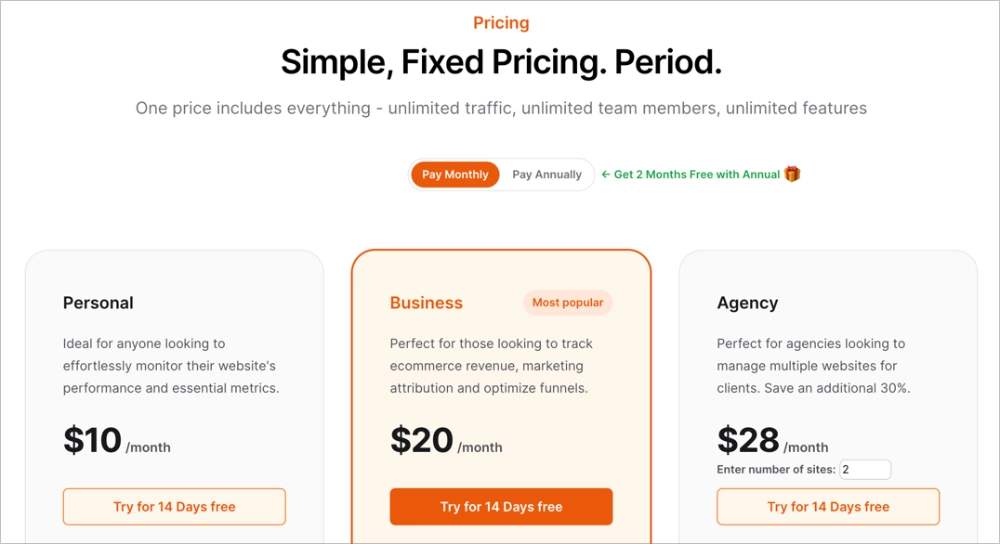
The real value comes from the time saved. Instead of digging through GA4, OnePageGA gives you a clear view of the numbers that matter most.
When to Use GA4 Alone vs With OnePageGA
GA4 is the right choice if you have the time and skills to dive into complex reports. It works well for data analysts, larger teams, or enterprises that need complete control and advanced integrations.
For small business owners, solo creators, and marketers, GA4 alone can feel like too much. This is where OnePageGA shines. By connecting it to your GA4 account, you get the clarity you need without the steep learning curve.
Here are a few examples:
- A blogger who wants to see which posts bring in the most traffic and signups will get faster answers with OnePageGA.
- An ecommerce shop can track top products and referral sales without building custom GA4 reports.
- A marketing agency can roll out OnePageGA across client sites to give business owners easy-to-read dashboards while still using GA4 for deeper analysis.
In short, GA4 works well on its own for technical users. But pairing it with OnePageGA makes analytics practical for everyday business use.
Pros & Cons
Every tool has its strengths and weaknesses. Here’s how GA4 and OnePageGA compare at a glance.
| Tool | Pros | Cons |
|---|---|---|
| Google Analytics 4 | – Free to use with no limits – Highly flexible with custom reports and funnels – Strong integrations with other Google tools | – Steep learning curve – Setup takes time |
| OnePageGA | – Simple dashboard that’s easy to read – Focused on business metrics that drive growth – Quick setup with no coding required – 14-day free trial | – Paid subscription after trial ends – Less advanced customization than GA4 – Works only alongside GA4 |
For a more detailed overview, see these Google Analytics 4 Pros and Cons.
FAQs About OnePageGA vs Google Analytics 4
Is GA4 enough for small business analytics?
GA4 can be enough if you have the time to learn it. But most small business owners find it too complex and prefer a tool like OnePageGA for clarity.
Does OnePageGA replace GA4?
No. GA4 collects the data, and OnePageGA organizes it into an easy-to-read dashboard. You need both to make it work.
Can I use OnePageGA without GA4?
No. OnePageGA connects to GA4, so you need a GA4 property set up first.
Which is better for beginners: GA4 or OnePageGA?
OnePageGA is better for beginners because it is simple to use. GA4 is better for advanced users who want full control.
How much does OnePageGA cost compared to GA4?
GA4 is free. OnePageGA has a 14-day free trial, then paid plans starting at $10 per month.
GA4 is powerful but overwhelming for most business owners. OnePageGA makes it practical by turning complex reports into a clear view of the numbers that matter.
If you want quick insights without the hassle, try OnePageGA free for 14 days and see the difference for yourself.
You may also find the following guides helpful:
- How to Increase Organic Search Traffic to Your Website
- How to Find Average Session Duration in Google Analytics
- How to Find Bounce Rate in Google Analytics 4
- How to Find Your Top Converting Traffic Sources in GA4
- How to Add Annotations in Google Analytics 4
If you have questions or want to join the conversation, you can also find us on X and Facebook.

